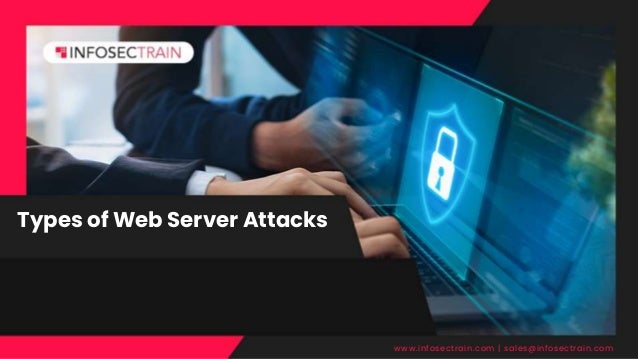Types of Web Server Attacks.pptx
•Download as PPTX, PDF•
0 likes•0 views
A web server is a piece of program that distributes web content using the HTTP protocol. A web server must host every website on the internet because it is the backbone of the internet. https://www.infosectrain.com/courses/ceh-v11-certification-training/
Report
Share
Report
Share

Recommended
Recommended
More Related Content
More from infosec train
More from infosec train (20)
Interpreting the Malicious Mind Motive Behind Cyberattacks.pdf

Interpreting the Malicious Mind Motive Behind Cyberattacks.pdf
PCI-DSS(Payment Card Industry Data Security Standard) Training .pdf

PCI-DSS(Payment Card Industry Data Security Standard) Training .pdf
Privacy Impact Assessment vs Risk Assessment vs Business Impact Assessment.pdf

Privacy Impact Assessment vs Risk Assessment vs Business Impact Assessment.pdf
Types of Web Server Attacks.pptx
- 1. Types of Web Server Attacks www.infosectrain.com | sales@infosectrain.com
- 2. www.infosectrain.com | sales@infosectrain.com What are web server attacks? A web server is a piece of program that distributes web content using the HTTP protocol. A web server must host every website on the internet because it is the backbone of the internet.
- 3. www.infosectrain.com | sales@infosectrain.com A web server attack is any deliberate attempt by a bad actor to compromise the security of a web server. An attack on the web server will result from any vulnerability in the network, operating system, database, or applications. Serious ramifications could include data tampering, theft, website vandalism, etc. All of this could result in a company getting a negative reputation and customers losing faith in it. Most common types of web server attacks: SSH Brute-Force Attack: The password used to identify a legitimate user and give access to the web server is frequently the foundation of a web server's authentication system. By trying all possible SSH login passwords, an SSH brute-force attack is utilized to acquire access. This kind of attack can be used to spread malicious files, drain a server's resources, and go unnoticed. Denial of Service (DoS) or Distributed Denial of Service (DDoS) Attack: In this attack, the web server is made to respond to a high number of request packets, which causes it to slow down or crash resulting in a denial of service or access to authorized users. Website Defacement: The hacker gains access and defaces the websites in this kind of attack. For various reasons, such as to disgrace or defame the victim, an attacker finds a way to change the website's files or contents without your consent.
- 4. www.infosectrain.com | sales@infosectrain.com Directory Traversal: In this attack, the attacker can get access from the application outside of the web root directory, which might allow them to run OS commands, obtain sensitive data, or access restricted directories. Web pages are stored in the root directory; however, the hacker focuses on directories that are not in the root directory. On older servers with flaws and vulnerabilities, it generally works well. Phishing Attack: It is carried out by fooling the victim into clicking a malicious link in an email. The user is forwarded to a fake website that is hosted on the attacker's server using the link. The attackers can then use the victim's login information to perform malicious actions on the genuine target website. Cross-Site Scripting (XSS): A malicious code is injected into web applications due to a security flaw. The victims run this code, which enables the attackers to get around access controls and pose as users. The hacker will then have access to data from web applications, such as cookies and session information. This kind of attack is most likely to affect websites with scripting errors. Session hijacking: It occurs when a web server uses a cookie to determine the user's session. This attack is carried out automatically using sniffing software. Man-in-the-Middle (MITM) Attack: It enables attackers to eavesdrop on the conversation between two servers in the MITM attack. To the victim, it will seem like a typical information exchange is taking place, but the attacker can covertly steal information by "middling" in the dialogue or data transfer.
- 5. www.infosectrain.com | sales@infosectrain.com Final words: In the modern internet era, we visit numerous websites for many daily tasks, and obviously, no one ever wants to experience web server attacks. Therefore, you can enroll in InfosecTrain's numerous cybersecurity courses like CEH, Web Application Penetration Testing, and CompTIA PenTest+ if you want to learn how to protect your web servers from attackers.
- 6. About InfosecTrain • Established in 2016, we are one of the finest Security and Technology Training and Consulting company • Wide range of professional training programs, certifications & consulting services in the IT and Cyber Security domain • High-quality technical services, certifications or customized training programs curated with professionals of over 15 years of combined experience in the domain www.infosectrain.com | sales@infosectrain.com
- 7. Our Endorsements www.infosectrain.com | sales@infosectrain.com
- 8. Why InfosecTrain Global Learning Partners Flexible modes of Training Tailor Made Training Post training completion Certified and Experienced Instructors Access to the recorded sessions www.infosectrain.com | sales@infosectrain.com
- 9. Our Trusted Clients www.infosectrain.com | sales@infosectrain.com
- 11. Contact us Get your workforce reskilled by our certified and experienced instructors! IND: 1800-843-7890 (Toll Free) / US: +1 657-722-11127 / UK : +44 7451 208413 sales@infosectrain.com www.infosectrain.com
